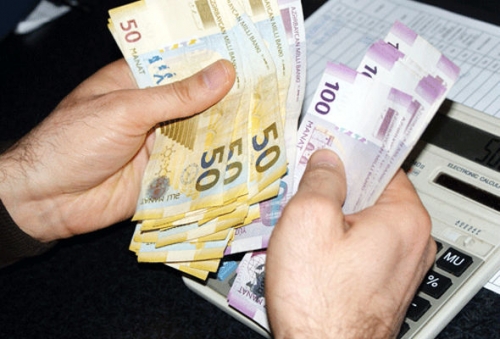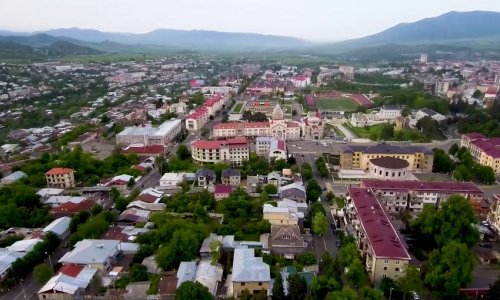The wave of currency collapses in the former Soviet Union is entering its second act.
Azerbaijan has burned through more than half of its central bank reserves to defend a currency that Standard & Poor’s says remains largely pegged to the dollar after it was allowed to weaken about 25 percent in February. Policy makers may have little choice but to devalue again as they steer an economy
reliant on hydrocarbons for more than 90 percent of exports.
Countries in Russia’s orbit from Belarus to Kazakhstan are finding it increasingly difficult to fight the gravity of their former master’s decaying economy.
Slumping crude and the ruble’s collapse are ushering in a new era of volatility for Azerbaijan, beset by challenges ranging from declining oil output to a festering conflict with neighboring Armenia. The focus is on the manat, which has had one annual drop against the dollar in the past 12 years.
"Given the buildup of external and regional pressures, not to devalue the manat at this stage would be akin to economic suicide,” said Chris Weafer, a senior partner at Moscow-based consulting firm Macro Advisory who expects such a move by early 2016. "The level of FX reserves is the key indicator. That is currently flashing bright red warning signals.”
Manat Pressure
The erosion of reserves at a $500 million daily clip was what forced the central bank’s hand in February, President Ilham Aliyev said in the days after the devaluation. The stockpile was at $6.8 billion at the end of last month, down from more than $15 billion a year earlier.
The manat weakened 0.4 percent to 1.0506 against the dollar as of 11:44 a.m. in Baku. It’s down less than 2 percent against the dollar since the devaluation. Governor Elman Rustamov has said the central bank is shifting to a "managed floating exchange rate,” warning that the currency would lose as much as 30 percent if it were allowed to trade freely.
Azerbaijan’s only earners of foreign currency are the central bank, the state-run crude producer Socar and the nation’s wealth fund, according to Rustamov. The State Oil Fund of Azerbaijan, known as Sofaz, has almost $35 billion assets, equivalent to more than half of gross domestic product. It
receives most of the government’s oil-linked revenue and uses transfers to finance the budget.
Tenge, Manat
Similarities between Azerbaijan and Kazakhstan -- two Muslim-majority nations on the opposite shores of the Caspian -- don’t end with their reliance on energy exports to power their economies. Boasting some of the biggest reserves in the region, both have resisted pressure on their currencies as contagion
from the crisis in Russia and oil’s 45 percent plunge in the past year rippled through the region.
Kazakhstan, which allowed the tenge to weaken 19 percent against the dollar last year, caved in again in August by cutting its currency loose. The central bank governor there was dismissed after spending 6 percent of reserves trying to smooth swings in what became the world’s most volatile currency after
it was allowed to trade freely on Aug. 20.
Depositor Exodus
The turmoil has prompted an exodus by savers from accounts in local currencies, heaping more pressure on banks and the foreign-exchange markets. In Azerbaijan, the share of foreign-currency deposits reached more than 70 percent in the months after the devaluation, from 51 percent at end-January, according to Fitch Ratings. In the Caucasus and central Asia, dollarization rates -- which show the role of the U.S. currency in the economy -- are already among the highest in the world, posing risks to macroeconomic and financial stability, the International Monetary Fund said in a September report.
"The central bank lacks a long-term strategy on the currency’s exchange rate,” said Qubad Ibadoglu, head of the Economic Studies Center in the Azeri capital, Baku. "It’s pursuing the old policy of intervention in the currency market to keep the manat rate stable in the short term.”
Azerbaijan is likely to weaken the manat by about 25 percent against the dollar early next year, according to the Economist Intelligence Unit. S&P said in July that it didn’t see a further devaluation during its 2015-2018 forecast horizon. Azeri central bankers have said in recent months that they saw no grounds for another devaluation.
Resisting Devaluation
That rings true to Demetrios Efstathiou, head of strategy for central and eastern Europe, Middle East and Africa at ICBC Standard Bank Plc in London. Unlike Kazakhstan, a member of an economic bloc with Russia, Azerbaijan is under less pressure from a weaker ruble, and its public finances are showing no signs of imbalance, he said. It also has its "massive” oil fund, according to Efstathiou.
"Two devaluations within a year aren’t advisable,” he said. "The dollarization ratio is extremely high, reaching its limit. But in itself, it’s not a reason to devalue.”
As the depletion of reserves shows persistent pressure on the manat’s peg, the central bank may not have a choice, according to Tatiana Orlova, a senior economist at Royal Bank of Scotland Plc in London. The relatively small size of the Azeri banking industry would limit the potential negative effects,
making a devaluation feasible, she said.
"Further devaluation would be positive, as the currency would act as a more effective oil price shock absorber, likely outweighing the negative effects on confidence and dollarization,” she said in an e-mailed report.
(Bloomberg)
www.ann.az
Follow us !











